#environment friendly diet
Explore tagged Tumblr posts
Text
What is Climate Education for Sustainable Living?
It is education that provides a sustainable future against climate change. Climate education for sustainable living makes people better able to take intelligent decisions to reduce their footprints on the environment. In short, one knows the science behind climate change so works towards a healthier planet.
One of the practical steps toward the causes of sustainability is a Sustainable Earth Eating Program. The Sustainable Earth Eating Program advocates making environmentally friendly choices with food that are both good for people and the planet. For example, a person would be called upon to minimize food wastage, have seasonal food that is locally produced, and have more plant-based meals rather than resource-intensive animal products.
The food industry is one of the largest contributors to greenhouse gas emissions, deforestation, and biodiversity loss. The Sustainable Earth Eating Program educates consumers about the impact of their diets and provides steps toward change. Replacing beef with legumes or increasing the amount of fruits and vegetables consumed in meals reduces a person's carbon footprint significantly.
Some of the programs offered by the platforms are included in Climate Education for Sustainable Living initiatives, such as ClimateDiet.org. These will play a very important role in further fostering awareness. Combining knowledge with tools and resources, the initiative enables these communities to adopt sustainable living practices about climate change through these practices. These efforts not only focus on the food system but also reflect the idea of energy efficiency, effective waste management, and sustainable lifestyles.
youtube
Climate Education for Sustainable Living
Climate education inspires systemic change. School, workplace, and government-based programs can then be integrated in sustainability-focused directions to influence wider communities. Children and adults learning sustainable living practices build a base for long-term climate resilience.
This is not a change of life in one night, but step by step towards changing some things around you. Change from single-use grocery bags to contributing to community gardening, or even institute a Sustainable Earth Eating Program. Every little counts.
It all begins with responsible decisions from all of us and inspiring others to do the same. The ultimate outcome of climate education and programs such as the sustainable earth eating program can be a reduction of harm done to the environment, and one can build a future in which people and the planet coexist.
Visit ClimateDiet.org to find resources, sign on initiatives, and learn how to drive change toward a more sustainable tomorrow for generations.
#Climate Education for Sustainable Living#environment friendly diet#climate-friendly diet tips#climate education program#animal agriculture deforestation#Youtube
0 notes
Text
Looking for a simple way to reduce waste in your life? Try reducing your food waste to start! Yes, bad food can be composted, but for many that's a nuisance, or not easily feasible- and, food you throw out is money in the bin. So here's 5 easy steps to reduce your food waste:
Keep a food journal for 1 week, with two columns. Column A is food you've bought (and the packaging it came in), column B is food you (or someone else) have eaten.
At the end of the week, tally up the difference, and write up everything you had to throw out: the packaging as well as any components you couldn't eat (bones, stalks, seeds, etc).
Assess this list. Next to each item of packaging, figure out if there is a low or zero waste swap. For example, glass milk bottles instead of plastic, loose veggies instead of in those silly bags, whole chicken rather than a bunch of pieces wrapped in too much plastic, bulk bin nuts rather than a lined bag, etc. Next to each item you couldn't eat, write things you could possibly do with those components. Broth from bones, calcium powder from eggshells, pickled watermelon rinds, anything, even if you might not actually want to eat it.
Use this information to write up exactly what you should have bought. Eliminate straight away anything you didn't eat, implement the lower waste options, and note next to each item what you could do with the excess.
Use what you have learned to approach your next shopping trip differently. You can use that exact list, or you can write a new list just as mindfully. Perhaps you need to shop more frequently for less food, so things stop going bad before your next trip. Perhaps you need to plan ahead and bring a list to the store. No matter what, it'll take time for you to adjust- but just repeat these steps every now and again to refine your approach to food, and you'll be well on your way to cutting down waste.
#zero waste#sustainability#anti consumerism#sustainable#eco friendly#environment#anti consumption#food#food waste#mindful eating#mindfulness#diet
13 notes
·
View notes
Text
My friend gave her hamster to me because she was moving cross-country and couldn’t bring him with her. His cage is one of those small wire double-decker cages and I feel so bad 😭 I can’t afford to get him a new cage for like over a month :(
#hamster#he’s really friendly and already#adjusted to the new environment tho#stressed about his food tho#I’m slowly changing his diet#i give my hamster the “plainest#foods possible#aka super basic ingredients#the food she fed him has#so much additives#he doesn’t even eat half#of it#cause most of it is filler seeds#i wanna get him a big 4 ft bin like mine#for a cage#eventually I wanna get a smaller#one to make a second-story for mine#sigh#vent#personal
15 notes
·
View notes
Text
Do u think becoming child labourers at elementary school/middle school ages stunted the growth of nct dream members. Like is there a universe where mark is a 5'11 business major who just graduated from u of t? Or where jaemin is a 6 foot tall surgeon or something? Much to think about. I have a project due in 15 hours that i haven't started btw

#this started as a joke but i think it mustve had an effect like developmentally . esp when they control their diets and stuff#someone should do a study on how becoming an idol who debuts at 15 years old affects u physically#and mentally like what is that prefrontal cortex development like for someone in such a non child friendly environment#and i hypothesize that the kpop idol journey does different things to u than just being a child star#like on one hand u have a group of ppl who are going thru the same thing but on the other hand its a lot more to ask of from a child#nct#sidney talks shit
10 notes
·
View notes
Text
The Ultimate Guide to an Environment-Friendly Diet: Eating for a Greener Planet
An environment-friendly diet is a conscious way of eating that minimizes the impact of food production on the planet. By focusing on sustainable, plant-based foods, reducing meat consumption, and choosing local produce, we can help preserve natural resources and reduce our carbon footprint. This guide explores how to adopt an environment-friendly diet and why it matters for the health of our…
#eco-friendly diet#environment-friendly diet#Green Living#healthy diet#plant-based eating#reducing carbon footprint#sustainable eating#sustainable food choices
0 notes
Text
#greensalad#greensaladin#healthyeating#healthyliving#weightloss#weightlossjourney#dietplan#weight loss diet#eco friendly#eco packaging#green planet#environment
0 notes
Text
7 Days Cardioprotective Vegan Diet Plan
7 Days Cardioprotective Vegan Diet Plan Embarking on a journey towards heart health doesn’t mean sacrificing flavor or variety. Our 7-day cardioprotective vegan diet plan is not just a menu—it’s a celebration of delicious, nutrient-dense choices that can make your heart sing. Let’s explore this plant-powered adventure together. Day 1: Plant-Powered Beginnings Breakfast: Energizing…

View On WordPress
#7 Days Cardioprotective Vegan Diet Plan#Adventure#Advice#art#Balanced Nutrition#Beauty#Blogging#Books#Business#Cooking#Creativity#Culture#Design#Diabetic-Friendly#DIY#Education#Entertainment#Environment#Family#Fashion#Fiber#Fiction#Fitness#Fitness Routines#food#Gluten-Free#Health#History#Humor#Inspiration
0 notes
Text
Green Eating: How to Make Sustainable Food Choices
Explanation of the connection between food and the environment Food production and consumption have a significant impact on the environment. The way we grow, process, and distribute food affects land use, water resources, and greenhouse gas emissions. On the other hand, the environment also has a significant impact on food production, from weather patterns affecting crop yields to environmental…

View On WordPress
#benefits of sustainable eating#carbon footprint of food#eco-friendly food choices#food and the environment#food waste reduction#green eating#here are some potential tags for the blog "green eating: how to make sustainable food choices":#local and seasonal food#organic farming#plant-based diet#reducing the impact of food production#seafood sustainability#supporting local communities and economy#sustainable food practices
0 notes
Text
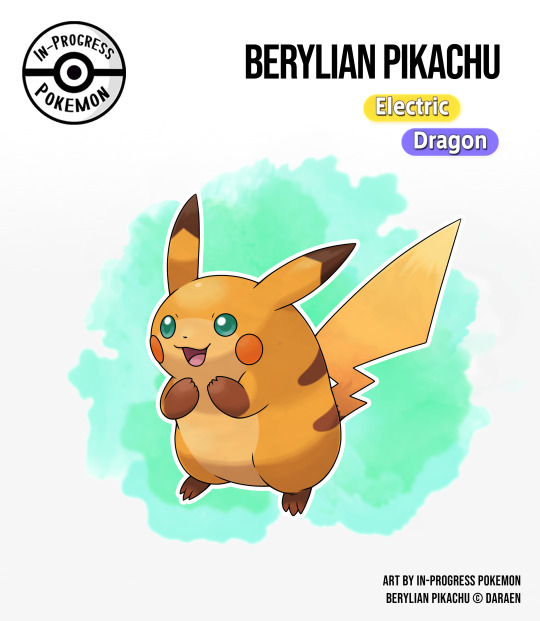

Berylian Pikachu
Electrodent Pokémon Type: Electric/Dragon Size: 2'00" | 26.5 lbs Ability: Fluffy or Thunderous: The Pokémon electrifies its body, allowing it to deal additional Electric damage with its physical moves and to attackers that make direct contact. The effect increases with an active Electric Terrain, but is canceled by sandstorms and other sand and mud-based moves. Hidden Ability: Electric Surge Evolution Method: Evolves from Pichu by leveling up with high friendship while in the Beryl Region
Description: Berylian Pikachu, unlike their temperate forest-dwelling counterparts, are adapted to the harsher, less wooded environments of Beryl. By changing their diet and becoming gluttonous, they have evolved to be larger, fluffier, with more muscle and fat, sacrificing speed and agility for enhanced physical attack, defense, and stamina. This allows Berylian Pikachu to deliver powerful blows, run long distances, and better protect young Pichu from predators. The mystical energy of the Beryl region also granted this line a Dragon-type, making them more aggressive and hostile towards most Pokémon, except other electric rodents. Berylian Pikachu's fluffy fur retains the electricity that is discharged from their cheeks, enabling them to electrify their physical moves or generate an electric shield when overcharged. Unlike the common Pikachu, the Berylian variant is nomadic, rarely staying in one place for long. When colonies meet, half of the newly evolved Pikachu migrate to new groups. Annually, during the rainy season, the oldest Pikachu gather in crystal-rich areas, causing storms as they dance until triggering their evolution into Gorachu.
---
Gorachu
Jackalope Pokémon Type: Electric/Dragon Size: 4'07" | 154.3 lbs Ability: Fluffy or Thunderous Hidden Ability: Electric Surge Evolution Method: Evolves from Berylian Pikachu while using Dragon Dance with an active Electric Terrain
Description: After completing the mysterious ritual, Berylian Pikachu evolve into Gorachu. While Gorachu become more friendly towards other Pokémon, they remain fiercely protective and aggressive when their colony is threatened. They develop belly pouches to carry young Pichu and their food, ensuring safety from any dangers during travels. In the wild, Gorachu collectively care for all the young Pichu, treating others' offspring as their own. Once trained, they become loyal partners, even babysitting their trainers' own children and other baby Pokémon. Using their powerful legs, Gorachu are able to leap great distances; however, their large size and lack of agility make it hard to stop or change direction quickly. When facing an opponent, they can lash by bashing them with their fluffy, electrified tails and jabbing with their horns, which are made of crystallized electric energy. If their horns break, they will grow back larger than before, symbolizing strength and experience. Berylian people craft accessories from these horn fragments, believing they bring luck and happiness. Some researchers speculate that Berylian Pikachu and Gorachu are the original forms of Pikachu and Raichu, with common variants being adaptations to less harsh environments; Kantonian myths and an article in the Scarlet book support this theory.
Berylian Pikachu and Gorachu were commissioned, designed by, and belong to Daraen. Thanks!
- - - - - - - - - -
Follow for more fake Pokemon evolutions!
FAQ | Social Media | Pokemon Index | Commission Information
#pokemon#fakemon#in progress pokemon#pikachu#gorachu#berylian pikachu#regional variant#regional form#dragon type#electric type#commission#Daraen#IPPcommission#long post
487 notes
·
View notes
Text
It’s time to break down the top ten pets we covered this past year before we move into the next! These pokémon would each make good house pets for most owners, and come with our official recommendation. This post will give a brief overview of what makes each candidate a top option. A little later, a separate post will provide the links to the full posts for each one. Let’s get into it!
10. Plusle and Minun
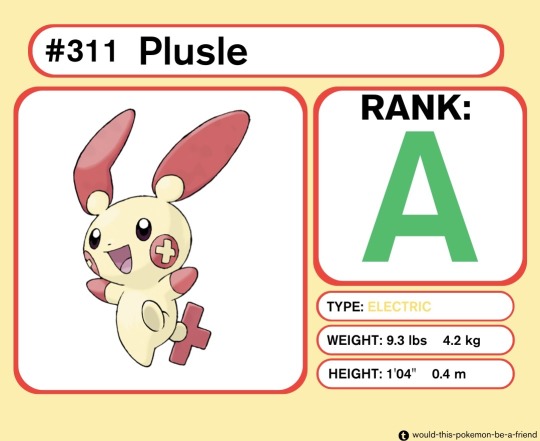

Stand-out pokémon from a type that tends to rank pretty lowly on this blog, both plusles and minuns would make good starting pets for someone interested in Electric-Type pokémon. While you’ll need to be careful of their paralyzing moves, some experts believe that these pokémons’ passive electric powers can have surprising health benefits. That being said, their ease of care isn’t the best (feeding these little friends will be more than a little expensive).
9. Piplup
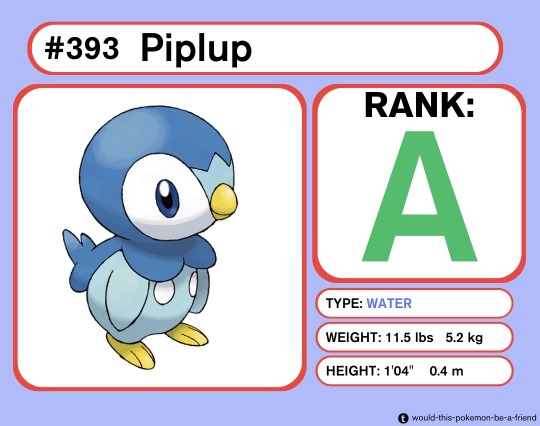
Piplups have quite the reputation for being unfriendly due to their prideful, haughty attitude, but once you break through that prickly exterior they can make a great pet. They aren’t the best Water-Type pokémon in this top ten, but if you’re looking for a new aquatic friend then a piplup may be a good choice for you (so long as you don’t mind swimming in the cold!).
8. Rowlet
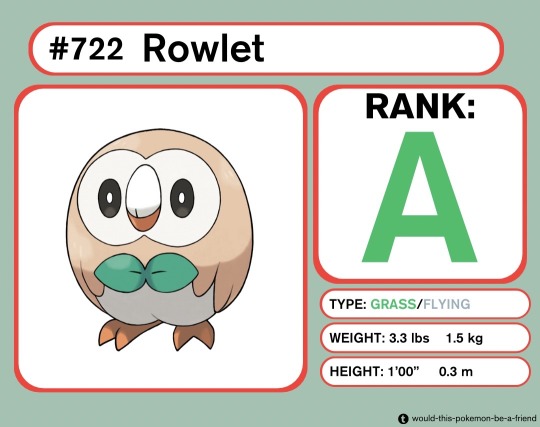
Pretty good year for bird-like starter pokémon! Rowlets are great fits for night owls who could spend some time on training. Plus, if you have a pest problem, a rowlet would be more than happy to help you out with it! They’re also just so unbelievable cute (maybe showing some bias there).
7. Nincada
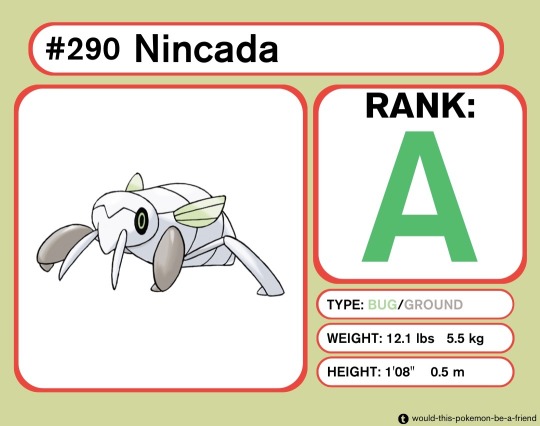
Good news for Bug-Type fans, you’ve got two great options in the top ten this year! Nincadas are pretty low maintenance, so the barrier for entry into caring for one is perfectly low for new owners. As I discussed in their post, however, you will need to keep in mind the commitment that you take on when adopting one: this is one species of pokémon whose entire lifestyle is geared towards evolution. While I have only discussed one of their evolutions thus far (shedinja), the ease of care and threat level of these evolutions is much higher. Experienced bug-type owners won’t have a problem, but newbies would need to consider this heavily before adoption.
6. Lotad

If you’ve got access to a pool of water for a Lotad to chill in, then you’ve got just the right environment for adopting one. These guys are friendly (at least to other pokémon), easy-going, and their needs aren’t very extreme. They may not be the most energetic or “exciting” pets, but lotads are a great candidate for an aquatic pet!
5. Azumarill
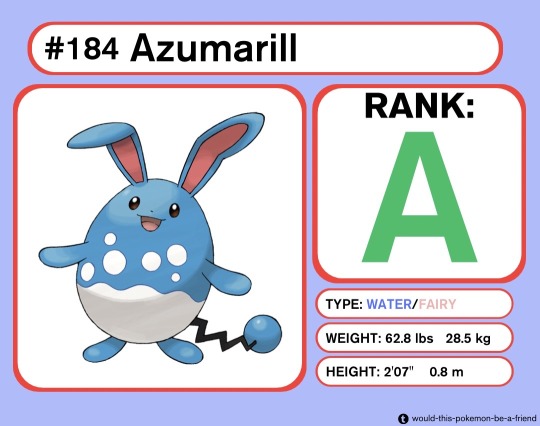
Like the lotads under them in this top ten, azumarills are simultaneously easy to care for and friendly, making them a great option. Like most Water-Types that we discuss, any potential azumarill owner will need to provide them with a place to play in the water, which might not be something everyone is able to provide, but beyond that, they would make a great companion. They’re playful, caring, and cute! What else do you need?
4. Snom

My personal favorite out of the top ten, it’s another delightful bug, snom! While there isn’t a vast wealth of data about this species, given how recently they were discovered, there is plenty of indication that they would make a safe, low maintenance pet. They may not be the most expressive, but their diet of snow and relatively low threat level makes them a great candidate, so long as you don’t mind keeping your home cool.
3. Meowth

That’s right, meowths are especially the same as regular cats, making them an excellent pet! Like regular cats, these pokémon are fickle and free-wandering, but the path to their heart is quite simply paved with shiny things. Plus, as a huge bonus, look at that charming face! If you’re a cat person, you’re a meowth person.
2. Dachsbun

So long as you can keep them safe from their many potential predators, due to their sweet smell, a dachsbun would make an excellent pet. Unlike meowths, who are essentially cats, dachsbuns are much more than “just-a-dog”: are you a baker or a farmer? A dachsbun would make the perfect companion for you due to their ability to provide yeast for baking and to help plants grow with their mysterious scent.
And finally, our number one pet option of 2024 is…..
1. Teddiursa
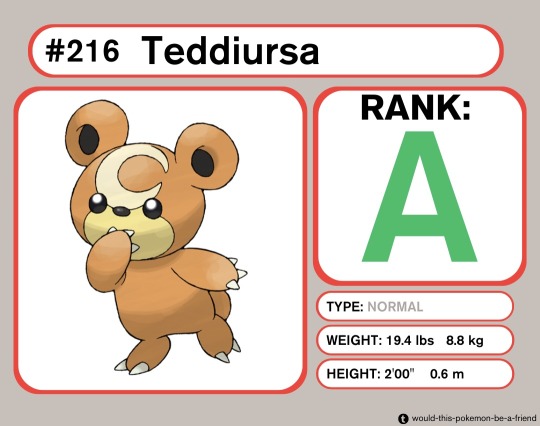
Adorable, safe, small, and easy to care for, teddiursas would make a great pet for any owner. Their diet is made up almost entirely of honey, which is pretty easy to come by. Plus, if you provide your teddiursa with the right raw materials, they can make their own, providing for a perfect play activity that they may even share with you. Just…uh… make sure you use an everstone, and you’ve got the perfect little friend.
Thank you for another great year of blogging! I truly appreciate all the ongoing support, and I hope to be even more active in 2025. Will a non-Normal-Type pokémon finally come out on top next December? Probably not. But let's see!
#pokémon#pokemon#pkmn irl#plusle#minun#piplup#rowlet#nincada#azumarill#lotad#snom#meowth#dachsbun#teddiursa
202 notes
·
View notes
Text
As the link between animal agriculture and climate breakdown becomes clearer, if anything, we are seeing more ordinary people falling over themselves to defend an industry that is destroying our planet, polluting our communities, exploiting animals and human workers. This is especially worrying to see from leftists, in spaces that are supposed to be progressive. I promise you, you do not need to spend your time greenwashing leather and wool, repeating blatant industry propaganda about veganism, 'regenerative agriculture' or whatever other buzzword they're using to sow doubt this week. The industry already spends millions of your dollars to lobby our politicians and influence public opinion; they don't need you to do it for free.
Vox – The greenwashing of wool explained
New Republic – The comforting lie of climate-friendly meat
Guardian – Big Beef’s climate messaging machine
The Breakthrough – Is Feedlot Beef Better for Environment?
International Journey of Biodiversity – Misinformation on Science of Grazed Ecosystems
Food Climate Research Network – Grazed & Confused
Science 2.0 – The regenerative ranching racket
DeSmog – A guide to six greenwashing terms
Truthdig – The backlash to plant-based meats
Independent – Meat & dairy industries downplaying role in climate crisis using tobacco tactics
Guardian – Meat & dairy lobbyists turn out in record numbers at COP28
Greenpeace – How Big Agriculture is borrowing Big Oil’s playbook at COP28
Guardian – Plans to present meat as ‘sustainable nutrition’ at Cop28 revealed
Guardian – Ex-officials at UN farming body say work on methane emissions was censored
Guardian – How UN food body played down role of farming in climate change
QZ – The meat industry blocked the IPCC’s attempt to recommend a plant-based diet
The Times – Red Tractor farms more likely to pollute environment
Influence Map – European meat & dairy industry weaken EU’s climate policies
The Grocer – Meat Industry lobbying behind cultured meat bans
Food Unfolded – Truth, tactics and the mist of meat lobby science
Business Green – Climate lobbying: Are meat and dairy lobbyists the ‘new merchants of doubt’?
132 notes
·
View notes
Text
5 Reasons to choose environment friendly diet
Each of our daily food choices significantly impacts the environment. We can make an important contribution to the reduction of greenhouse gases, conservation of water, and biodiversity protection through an environment friendly diet. Changing to a climate-friendly diet doesn't mean having to sacrifice flavor or diversity. Instead, it is simply about making choices that benefit us both in terms of health and planet.
1. Prioritize Plant-Based Foods
An Environmentally friendly diet inherently requires fewer resources to be produced, so start substituting your meals with more fruits, vegetables, legumes, and whole grains. Start with your "Meatless Monday" or plant-based recipes that do not depend on animal-based food, which is usually produced resource intensively.
2. Opt for seasonal and local foods
Buying local and seasonal produce reduces carbon footprint due to transportation and storage. Farmers' markets and community-supported agriculture programs are excellent sources of fresh, seasonal food. What's more, eating seasonally ensures you enjoy the freshest flavors while supporting local economies.

Environment friendly diet
3. Minimize Food Waste
Food waste is one of the major causes of climate change globally. Composting is another excellent way to turn food scraps into nutrient-rich soil, reducing methane emissions from landfills.
4. Opt for Sustainable Proteins
If you do consume meat or fish, ensure it is sourced sustainably. Poultry is also preferable to beef or lamb since it has a lower impact on the environment. Sustainable seafood that's been certified by organizations such as the MSC, Marine Stewardship Council, can also be considered.
5. Limit Processed Foods
Highly processed foods often come with a larger carbon footprint due to extensive manufacturing and packaging. Focus on whole, unprocessed ingredients to reduce your environmental impact and improve your health.
With these minor yet practical changes, you can bring your eating culture in harmony with your environment. It is not just your responsibility toward climate-friendly diet tips; rather, it serves as one step toward greater collective action for a sustainable future.
#environment friendly diet#climate education for sustainable living#sustainable diets climate impact#impact of animal agriculture on climate#animal agriculture deforestation
0 notes
Text
It’s amusing to me that beeswax is specifically named here, because it’s eco friendly but non-vegan, when usually veganism is touted AS eco friendly. If truly getting beeswax from a local beehive, this is a great solution. (we’re talking about hand-making the thick wax wraps cheese wheels used to come in, right?) Dunno if it is if it’s not- there are a lot of different plastic alternatives out there
Secondly, unless you are also getting a live or newly dead local chicken that wasn’t fed any store-bought feed, eating chicken in the first place is a Reduce swap you should be making- buy plant food or eggs instead.
This minimizes resources used in the supply chain quite a lot.
Local is best but the swap math works out for regular groceries too if your budget is slim. Egg prices should come back down when the population of chickens recovers from this latest blow. potatoes, oats, rice, legumes, are all the most affordable things that exist.
Easy zero waste tip no. 3: Know your R's
Refuse: If you don't acquire the thing that will become waste in the first place, it won't produce further waste. Simple enough. Refuse that which you do not need. Example: All that cute stuff on that Buzzfeed article? You don't need it. Don't even click the link.
Reduce: If you need something, get the minimum. Note that this doesn't mean the cheapest option- it means the most effective and environmentally friendly option. Example: Instead of buying disposable razors, or a razor with changeable heads, try out a safety razor. Instead of using plastic toothbrushes, try out bamboo, and instead of toothpaste in disposable tubes, try out some toothpaste bits. Instead of buying chicken breasts for one thing and chicken broth for another, get a whole chicken and learn to butcher its meat, and make broth from the skin and bones.
Reuse: This means both being mindful of purchases, so you're only buying things that are reusable whenever possible (Example: use beeswax wrap instead of saran wrap), and repurposing things you've already bought (Example: use those little Oui yogurt containers to start seeds for your garden).
Recycle: Find out what your local recycling program actually recycles, and be mindful. Aluminum is a safe bet most of the time, as is paper/cardboard; but plastics, most of the time, are a dud, so try to refuse, reduce, and reuse plastic whenever possible so you don't even need to worry about recycling it. This also refers to donation- that's another valid way to recycle things!
Rot: If you have a yard, start a compost pile! Just try to get a 50/50 balance of food scraps to brown matter (paper, dry leaves, etc). If you have a freezer, you can stick a container in there to act as a compost thing until you can bring it to a compost facility, such as a local garden, or farm. If you don't have the ability to do either of these things, then you can see if there's a subscription compost service in your area (I used CompostNow for ages, they're great).
Understanding these five principles, and looking at them in this order, can make things easier. Next time you're buying something, or about to throw something away, consider which of these might allow you to reduce your waste output in the future.
#feed conversion ratio#plant based diets#ovo vegetarian#eco friendly#sustainability#anti consumerism#anti consumption#sustainable#environment#refuse reduce reuse recycle rot#reduce reuse recycle#eat local
244 notes
·
View notes
Text

Inspired by this post, I've decided to propose a list of hypothetical Primarch fursonas.
Lion El'Johnson: Call me uncreative but it's all in the name. Lion.
Fulgrim: Reticulated python, but the kind specially bred for iridescent scales. Beautiful, dangerous, carefully curated for perfection.
Perturabo: I'm actually stumped here. Open to suggestions.
Jaghatai Khan: Couldn't decide between horse and eagle, so we'll go with hippogriff.
Leman Russ: Basic Bitch #2: Wolf.
Rogal Dorn: Polar bear. Big, dangerous, from a hostile ice environment, white hair.
Konrad Curze: Bat, specifically little brown bat, one of the lil cute fuckers.
Sanguinius: Trumpeter Swan. Beautiful, elegant bird that will absolutely fuck you up if you piss it off.
Ferrus Manus: Scaly-foot gastropod. Weird ass snail that grows iron scales and lives in undersea volcanoes.
Angron: Quokka. Gentle, docile, cute face structured in such a way that it's impossible for it to frown. Everything Angron was made to be but wasn't.
Roboute Guilliman: Domestic bull. Cattle are very...practical animals, if that makes sense. Widespread, useful, strong. Were often used as currency in ancient times. Deceptively "boring", cute as fuck. Sounds like our boy, and we all know how much he likes farms. Moo moo motherfucker.
Magnus the Red: We're going all out on the Egyptian imagery here folks. A gryphon, but with 2 very specific component animals. The sacred ibis is associated with Thoth, a god of wisdom and knowledge. They are also nasty little trash goblins that will raid your dumpster. Barbary lions were associated with kingship, also hair floofy. And fuck it, throw some snakes scales in there too, as Heka, the Egyptian god most strongly associated with magic, had a connection to serpents.
Mortarion: As you can tell, my indecisive ass loves hybrid sonas. Turkey vulture, not traditionally pretty, eats gross and yucky things, so important yet so undervalued. Good sense of smell, especially for a bird. Thematic association with death. Broad diet and adapts well to lots of environments. Spanish moon moth, bug with pretty green and black wings.
Corvus Corax: His name is literally the scientific name for common raven. If it aint't broke, don'y fix it.
Vulkan: Fire salamander/gila monster.
Lorgar: Domestic sheep. The "lamb of God" imagery was too strong. But he's a ram now, angry AF with horns to match.
Horus: Domestic dog. Friendly, charismatic, intelligent, loyal. But can turn on you, given the right circumstances. He'd a mutt, the unnervingly perfect spotty, floppy eared mutt, the "Fido" of an idealized heterosexual white suburban family unit, pickett fence and 2.5 kids. So perfect you can just tell that something is off.
Alpharius and Omegon: Planarian flatworm. You know why.
#warhammer 40k#warhammer 40000#wh40k#primarchs#roboute guilliman#konrad curze#horus lupercal#sanguinius#mortarion#fulgrim#corvus corax#angron#lorgar aurelian#vulkan#magnus the red#ferrus manus#leman russ#lion el'jonson#alpharius#omegon#rogal dorn#jaghatai khan#perturabo#guillicow
269 notes
·
View notes
Note
Part 1 of 3
Hello. I've been busy. But I'm once again reaching out to the dean sympathizers to finally see reason. Let's discuss climate change metaphors. Now, are we really gonna pretend that a show called "Supernatural" (as in 'above nature'), in which the main characters are literally hunters, isn't about destroying the environment? Because there are countless examples of this theme.
Who is at the helm of subjugating the planet? Everyone's favorite older brother, of course. It is dean's greatest desire to become the world's apex predator, supplanting other beings at the top of the food chain (those he deems as "monsters"), and inheriting the Earth as his own. Note: that is episode title of 15 x 20. Even the angels and G*d himself acknowledge the way dean disrupts the ecosystem or the 'natural order' as they say. In the world of Supernatural, hunters eliminate supposed threats, selfishly putting human power above the welfare of all. This parallels real-life hunters in America displacing wolves before efforts were made to restore them in Yosemite National Park. It's not a coincidence that he felt at home among other predators in Purgatory.
Part 2: Sam What is more intriguing and tolerable is the way Sam, and even cass react to dean’s megalomania. Although dean forces Sam and cass at his side into the life of hunting to achieve his goals, he narcissistically insists that Sam himself is a monster. He states this clearly a couple of times, but the brothers’ opposing food choices also exemplify that Sam is subhuman to a hunter like dean. Consider even the way his slobbish habits are contrasted to Sam in episodes such as Tall Tales, establishing Sam’s own relationship with food as “clean”. Clean for the environment, I say. Sam, the show’s metaphorical climate warrior, does his best to eat a sustainable diet like other passive herbivores such as cows. The fact that dean calls it “rabbit food” is obvious proof that dean literally believes Sam is prey. It is no coincidence that the cattle industry largely contributes to greenhouse gasses, and dean loves eating burgers made of this beautiful herbivore. Part 3: cass In fact, the love of beef perfectly displays cass’ failure to emulate Sam’s environmentally friendly virtue, under dean’s grooming. Even though he states that it is the hunger of his vessel, Jimmy, this is a misleading detail in My Bloody Valentine. Because he is new to emotions, he is a vulnerable, blank canvas to dean as a corrupting influence. He infects cass with his desire to take the Earth as well as burgers. Conversely, dean’s gluttony is so large that it can’t be perceived and augmented by Famine. He is dead inside, and his rot will poison the Earth. Later, with a matching hunger, cass spirals in season six, eventually becoming the “new God”, literally consuming the souls of monsters to do so. This arc of cass eating the Leviathans in his hubris and exploding in the lake is yet another metaphor for overconsumption and pollution destroying the environment. Sam, his “monstrous” powers and autonomy stripped, and cass, mind and heart polluted, are powerless to stop dean’s terrorism on the world of Supernatural during the later seasons. It is only in the end when the Earth is free from dean and his brainwashed kitten cass, that Sam and the rest of world live on. This is why the finale is a clean, green victory! part 4: oops oh my god I totally forgot about cass being dismissed as "crazy" for taking a strong interest in animals and nature in season seven while processing his guilt for his actions in season six. the bees. arguing against animal testing for makeup on monkeys. etc. these references to the environmental destruction are really obvious in Supernatural sometimes.
Part 3 is my favorite.
30 notes
·
View notes
Text
Caring for Your Comedic Companion: A Guide to Proper Clown Care
Creating a Clown-Friendly Environment: The Chuckle Chamber
Clowns thrive in environments that stimulate their comedic instincts. Before adopting your clown, ensure you have a dedicated space in your home for them, commonly referred to as the "Chuckle Chamber." If you cannot afford to buy a new enclosure, an old tent painted with stripes can keep your clown happy for the first few months. Equip it with a variety of colorful props, oversized shoes, and a well-stocked assortment of rubber chickens. Ensure the Chuckle Chamber is spacious enough for your clown to express its natural exuberance.
Nutritional Needs: A Diet of Delightful Delicacies
Maintaining a well-balanced and joy-inducing diet is crucial for your clown's health. Offer a mix of cotton candy, popcorn, and custard pies to meet their nutritional needs. For hydration, a continuous supply of seltzer water is recommended. Regularly check for any allergies or sensitivities your clown may have to certain treats. Surprisingly, peanut allergies are common amongst certain breeds of clown.
Exercise and Enrichment: Laughter Workouts
Clowns are energetic beings that require regular exercise and mental stimulation. Engage your clown in laughter workouts, which can include juggling sessions, pratfall practice, and balloon animal sculpting. Introduce new comedic routines to keep their minds sharp and their spirits high.
Grooming: Maintaining the Mirthful Mane
Clown grooming is not just about appearance; it's an essential aspect of their well-being. Regularly check and clean oversized shoes to prevent slips, trim colorful wigs to maintain their vibrant allure, and ensure that the iconic red nose is kept in pristine condition. A well-groomed clown is a happy and confident one.
Veterinary Care: Honk-Checked Health Checks
Regular visits to a certified clown veterinarian are crucial to monitor your companion's health. These professionals specialize in honk-checked health checks, ensuring that your clown is in peak comedic condition. Vaccinations against gloom and routine screenings for joke deficiencies are standard procedures.
Socialization: Playdates with Fellow Funnymakers
Clowns are social beings that thrive on interaction with their own kind. Arrange playdates with fellow clowns to encourage socialization and the exchange of humorous antics. Attend clown conventions, where your companion can partake in the grandeur of collective laughter and collaborative performances.
Understanding Non-Verbal Communication: Mastering the Art of Clownish Signals
Clowns communicate primarily through non-verbal cues, such as honks, squeaks, and exaggerated gestures. Pay close attention to your clown's signals to gauge their mood and preferences. Understanding the art of clownish communication is key to fostering a strong bond with your comedic companion.
Celebrating Special Occasions: Clown Birthdays and Anniversaries
Marking special occasions in your clown's life adds a touch of festivity to their existence. Celebrate birthdays with a clown-sized cake and a chorus of joyous honks. Recognize adoption anniversaries with a memorable performance or a specially crafted routine to commemorate the time spent together.
Providing proper care to your beloved clowns is not just a responsibility but a joyful journey of shared laughter and merriment. By embracing the unique needs and whimsical nature of your clown companion, you'll cultivate a bond that transcends the ordinary, creating a lifetime of cherished comedic moments.
#clownery#clowncore#clown posting#clown art#clown#clown husbandry#Clowns#Unicycles#Parties#Pranksters#Jesters#Mimes#Clownblr#Clown care#Clownology#Clownologist
219 notes
·
View notes